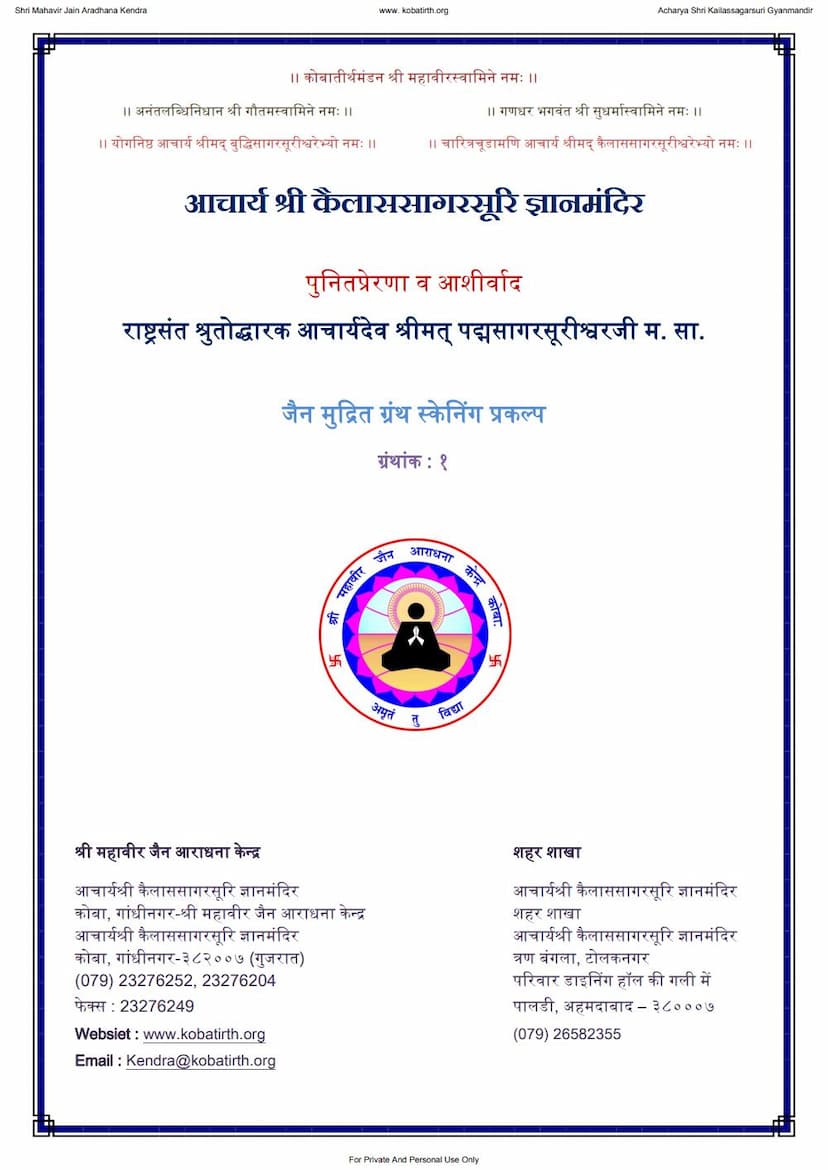Historical Inscriptions Of Gujarat Part 02
Added to library: September 1, 2025

Summary
The book "Historical Inscriptions of Gujarat Part 02" by Girjashankar Vallabhji Acharya, published by The Forbes Gujarati Sabha, is a comprehensive compilation of historical inscriptions found in Gujarat, covering the period from ancient times up to the end of the Vaghela dynasty. This summary focuses on the content related to Jainism and the historical context provided by the inscriptions.
Overview of the Book'This book, part of the Shree Forbes Gujarati Sabha Series No. 15, is the second volume of a larger project aimed at documenting historical inscriptions in Gujarat. Edited by Acharya Girjashankar Vallabhji, it contains inscriptions from various historical periods, detailing grants, royal decrees, religious endowments, and social information. The text is presented in Gujarati, with transliterations and translations where available, highlighting the linguistic and paleographic aspects of the inscriptions.
Jain Content within the Inscriptions: While the book covers a broad range of historical inscriptions, specific mentions or implications of Jainism can be inferred from the following:
- Temple and Religious Site Grants: The inscriptions frequently record land grants, donations, or endowments to temples and religious institutions. While the primary focus might not always be Jain temples, the presence of such grants within a broad historical context can indirectly point to the patronage of Jainism during those periods. The book details inscriptions related to temples and religious sites, and it's possible that some of these were Jain temples or supported Jain monastic communities.
- Royal Patronage: The inscriptions often mention the reigning kings and their decrees. The patronage of Jainism by rulers like the Chalukyas and Rashtrakutas is historically documented, and inscriptions from their reigns could contain references to Jain religious activities, grants to Jain monks, or the construction of Jain temples. The book covers inscriptions from the Gurjar dynasty, Chalukya dynasty, and Rashtrakuta dynasty, all of which had periods of Jain patronage.
- Social and Economic Information: Inscriptions can also provide indirect insights into the social and economic conditions of the time, including the presence and influence of various religious communities like the Jains. Land grants, for instance, might specify the beneficiaries, and if these include Jain monasteries or individuals associated with Jainism, it sheds light on their societal standing.
- Specific Inscriptions: While the provided text is primarily the book's title page and introductory/cataloging information, the latter parts of the text (pages 15 onwards) list specific inscriptions with details such as:
- Dynasty: Gurjar dynasty, Rashtrakuta dynasty, Chalukya dynasty.
- King: Jayabhata, Dadda, Govinda, Kark, Krishna, Dhruva, Bhima, Jayasimha, Kumarapala, Ajayapala, Mulraja.
- Dates: Specific Vikram Samvat and Saka Samvat dates are provided for each inscription.
- Location: Names of villages and cities where the inscriptions were found (e.g., Kavi, Sankheda, Umetra, Bagumra, Navsari, Valabhi, Vadnagar, Kadi, Sihor, Mangrol, Junagadh, Prabhas Patan, Uchchishira, Kherda, Ujjain, Khandesh, Saurashtra, Abu, Girnar, etc.).
- Content: Brief descriptions of the inscriptions often mention grants of land, donations, or religious purposes.
Historical Context: The inscriptions provide a rich tapestry of Gujarat's history, including:
- Dynastic Succession and Rule: The detailed listing of kings and their regnal periods helps in understanding the dynastic succession and the extent of their territories.
- Administrative and Economic Practices: Grants of land and revenue often reflect administrative structures, taxation systems, and economic activities of the time.
- Religious Tolerance and Patronage: The presence of grants to various religious communities, including potential Jain institutions, points to the religious landscape and the level of royal patronage or tolerance towards different faiths.
- Geographical and Cultural Information: The inscriptions mention various locations, topographical features, and social customs, offering valuable geographical and cultural insights into ancient and medieval Gujarat.
Methodology and Presentation: The book's approach involves:
- Collection and Preservation: The inscriptions are collected, documented, and preserved, ensuring their availability for future research.
- Transliteration and Translation: The original scripts are transliterated and translated, making the information accessible to a wider audience.
- Editorial Notes and Analysis: The editor and contributors likely provide historical context, paleographic analysis, and critical evaluation of the inscriptions, as indicated by references to scholars like D. R. Bhandarkar, H. H. Dhruva, G. Buhler, J. F. Fleet, and H. Cousens in the provided text.
In summary, "Historical Inscriptions of Gujarat Part 02" serves as a crucial primary source for understanding the political, social, religious, and cultural history of Gujarat. While the provided snippet doesn't detail specific Jain inscriptions, the comprehensive nature of the work, covering multiple dynasties and locations, suggests that it likely contains valuable information related to the Jain community and its historical presence in Gujarat.